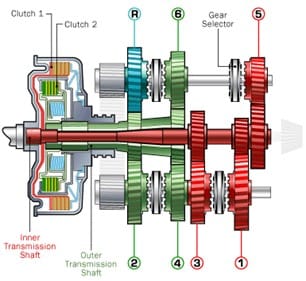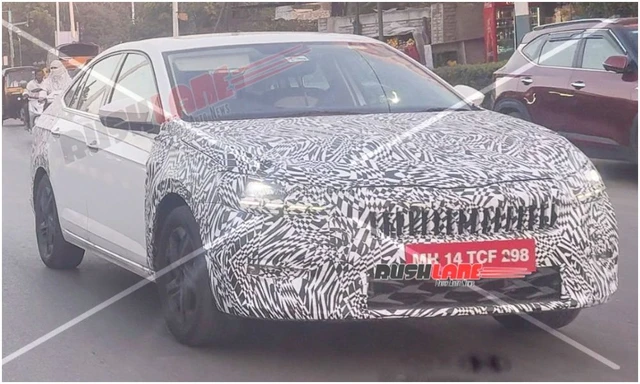Dual Clutch Automatic Transmission Explained

The evolving transmission systems can seem to be a complex subject if you do not follow the auto industry regularly. Over the years, different transmissions systems have made it to the market. Manual transmission has been around for the longest. However, it isn´t easy to drive and that forced automakers to consider alternatives.
One such alternative is a dual-clutch automatic transmission. Before you head out to buy your next car, learn about dual-clutch automatic transmission and understand if it's the one for you. Let us explore more about this transmission system!
What Is Dual-Clutch Automatic Transmission (DCT)?
Dual Clutch Automatic Transmission is also referred to as Direct Shift Gearbox. Most automakers have their unique version of DCT. However, they use DCT selectively across their range. Like so many innovations in vehicle transmission, the dual-clutch automatic transmission is a concept that has been there for years but is only new being out to use.
The Porsche 956, launched in 1983, was the first vehicle to sport a DCT. Several built-in computers help DCT to function. These computers prevent the need for manual inputs to shift gear. In other words, DCT automates the process of changing gears.

Photo Credit: www.matfoundrygroup.com
How Does Dual Clutch Transmission (DCT) Work?
With that introduction, you might have a fair idea about DCTs now. But, how does a dual-clutch transmission work? One of the primary benefits of DCT is that it minimises the time gap between changing gears.
In this transmission type, computerised clutches have a concentrical placement. Also, the crankshaft is connected to the clutch and is always ready to change to another. The countershafts have two cylindrical shafts that are independent. One of the countershafts in DCT is for even gear numbers, while the other is for odd.
The computer automatically anticipates the following gear ratio when the output shaft runs at a specific gear ratio. For this purpose, the computers analyse acceleration, deceleration, engine speed, and ongoing speed.

Pros of Dual Clutch Transmission (DCT)
Several benefits of opting for a vehicle with a dual clutch automatic transmission. We have discussed a few below:
- DCTs tend to offer better fuel efficiency than other automatic transmissions. It also delivers a smoother and seamless performance.
- Owing to their fuel efficiency and high-quality performance, many fleet owners prefer DCTs. Due to these advantages, DCTs are also ideal for significant long-term savings.
- Since they allow to shift gears smoothly and swiftly, the dual-clutch automatic transmission has also found its place in performance driving.

Photo Credit: mediapool.bmwgroup.com
Cons of Dual Clutch Transmission (DCT)
Each type of transmission comes with its cons. However, the cons of DCT are pretty easy to navigate over time. In any case, let's look at the setbacks of dual-clutch automatic transmission:
- Most car owners claim that DCT is more complex than other transmission systems.
- Also, DCT takes more room under the hood than any other transmission system.
If we compare Dual-clutch transmission to manual, CVT or any other transmission, DCT emerges as the winner. By navigating some of its downfalls, DCT can become the next big thing in automobiles.
Trending News
Latest News
 car&bike Team | Dec 13, 2025Skoda Slavia Facelift Spied Testing Again Ahead Of DebutThe facelifted Slavia is expected to debut in 2026 as Skoda-VW India looks to refresh its India 2.0 range.1 min read
car&bike Team | Dec 13, 2025Skoda Slavia Facelift Spied Testing Again Ahead Of DebutThe facelifted Slavia is expected to debut in 2026 as Skoda-VW India looks to refresh its India 2.0 range.1 min read car&bike Team | Dec 13, 20252026 MG Hector Facelift Interior Previewed Ahead Of DebutLatest teaser video of the upcoming Hector facelift suggests minimal cosmetic changes to the interior as well as reveals a new alloy-wheel design.1 min read
car&bike Team | Dec 13, 20252026 MG Hector Facelift Interior Previewed Ahead Of DebutLatest teaser video of the upcoming Hector facelift suggests minimal cosmetic changes to the interior as well as reveals a new alloy-wheel design.1 min read Jaiveer Mehra | Dec 13, 2025Passenger Vehicle, Two-Wheeler Sales Surge In November 2025: SIAMBoth segments reported a growth in the region of 20 per cent, though year-to-date sales growth in FY2026 was notably flatter at around 3 per cent.1 min read
Jaiveer Mehra | Dec 13, 2025Passenger Vehicle, Two-Wheeler Sales Surge In November 2025: SIAMBoth segments reported a growth in the region of 20 per cent, though year-to-date sales growth in FY2026 was notably flatter at around 3 per cent.1 min read car&bike Team | Dec 12, 2025Nissan Entry MPV Design To Be Unveiled On December 18New MPV to be the first of three new models for India by Nissan, alongside the Tekton and a three-row SUV.1 min read
car&bike Team | Dec 12, 2025Nissan Entry MPV Design To Be Unveiled On December 18New MPV to be the first of three new models for India by Nissan, alongside the Tekton and a three-row SUV.1 min read Jaiveer Mehra | Dec 12, 2025New Mini Convertible Launched At Rs 58.50 LakhDrop-top variant of the iconic Cooper hatchback available in a single Cooper S spec.1 min read
Jaiveer Mehra | Dec 12, 2025New Mini Convertible Launched At Rs 58.50 LakhDrop-top variant of the iconic Cooper hatchback available in a single Cooper S spec.1 min read car&bike Team | Dec 12, 2025Mahindra XUV 7XO Pre-Bookings Open December 15The mid-cycle update to the XUV 700, the XUV 7XO, is set to borrow design elements and tech from the new Mahindra XEV 9S.2 mins read
car&bike Team | Dec 12, 2025Mahindra XUV 7XO Pre-Bookings Open December 15The mid-cycle update to the XUV 700, the XUV 7XO, is set to borrow design elements and tech from the new Mahindra XEV 9S.2 mins read
 Janak Sorap | Dec 11, 2025Harley-Davidson X440 T First Ride Review: Smarter and SharperHarley-Davidson has taken the X440 and given it a more focused and engaging twist. The result is the X440 T—essentially the same platform but updated in areas that give the motorcycle more appeal and riders more thrill.5 mins read
Janak Sorap | Dec 11, 2025Harley-Davidson X440 T First Ride Review: Smarter and SharperHarley-Davidson has taken the X440 and given it a more focused and engaging twist. The result is the X440 T—essentially the same platform but updated in areas that give the motorcycle more appeal and riders more thrill.5 mins read Shams Raza Naqvi | Dec 10, 20252025 Mini Cooper Convertible Review: More Colour On Indian RoadsThe updated Mini Cooper Convertible is set to be launched in the Indian market in the next few days. We drive it around Jaisalmer for a quick review.1 min read
Shams Raza Naqvi | Dec 10, 20252025 Mini Cooper Convertible Review: More Colour On Indian RoadsThe updated Mini Cooper Convertible is set to be launched in the Indian market in the next few days. We drive it around Jaisalmer for a quick review.1 min read Bilal Firfiray | Dec 8, 2025Tata Sierra Review: India’s New Favourite?Marking its return after a few decades, the reborn Sierra has made everyone sit up and take notice. But is it worth the hype?10 mins read
Bilal Firfiray | Dec 8, 2025Tata Sierra Review: India’s New Favourite?Marking its return after a few decades, the reborn Sierra has made everyone sit up and take notice. But is it worth the hype?10 mins read Girish Karkera | Dec 4, 20252026 Honda Prelude First Drive: Domesticated Civic Type RA sporty-looking coupe built to give customers a taste of performance but not at the expense of everyday practicality.5 mins read
Girish Karkera | Dec 4, 20252026 Honda Prelude First Drive: Domesticated Civic Type RA sporty-looking coupe built to give customers a taste of performance but not at the expense of everyday practicality.5 mins read Seshan Vijayraghvan | Nov 29, 2025Mahindra XEV 9S First Drive Review: Big Electric SUV, Bigger ExpectationsThe XEV 9S lands at a time when the EV crowd is growing fast. It’s a big, born-electric, three-row SUV that starts under 20 lakh. It sits close to the XUV700 in size, but the brief is very different. Here’s what it’s like on the road.11 mins read
Seshan Vijayraghvan | Nov 29, 2025Mahindra XEV 9S First Drive Review: Big Electric SUV, Bigger ExpectationsThe XEV 9S lands at a time when the EV crowd is growing fast. It’s a big, born-electric, three-row SUV that starts under 20 lakh. It sits close to the XUV700 in size, but the brief is very different. Here’s what it’s like on the road.11 mins read

































































































































